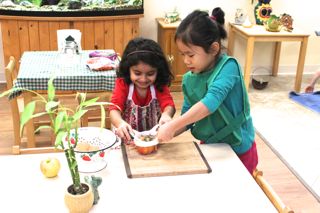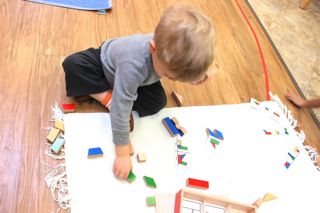What is Montessori?
It comes as a surprise to many people when they learn how Montessori schools were originally established. Montessori began with a real person, the first Italian woman medical doctor and single mother, Dr. Maria Montessori.
Dr. Montessori worked in the Psychiatric Clinic at the University of Rome, and began working with “special needs” children from the insane asylums. These children succeeded so well that Dr. Montessori was hailed around the world as a “miracle-worker.” Already a lecturer at the University of Rome, she continued her own education by studying philosophy, anthropology and psychology.
After suffering through and scrutinizing her own tumultuous early education, and observing and devising ways of educating the special needs children, she realized in order to truly serve all children, education needed to be vastly improved.
With this definitive goal in mind, Dr. Maria Montessori observed and studied the needs and tendencies of children throughout the world.
 She discovered that universally, children have the same needs and tendencies, and are naturally motivated with a great desire to learn and acquire the same skills as the adults around them. She observed that children learn by using their hands, exploring their environments with all of their senses, and imitating the language and actions of the adults directly around them. Most importantly, Dr. Montessori observed when children were: allowed the freedom to explore their environments, allowed to use real tools for real purposes, allowed the time and freedom to follow their own interests, guided to make their own discoveries, given the space to be “friendly” with their errors, encouraged to become independent, and helped only when they needed to be helped – that these children were joyful and confident learners – always wanting to do and know more.
She discovered that universally, children have the same needs and tendencies, and are naturally motivated with a great desire to learn and acquire the same skills as the adults around them. She observed that children learn by using their hands, exploring their environments with all of their senses, and imitating the language and actions of the adults directly around them. Most importantly, Dr. Montessori observed when children were: allowed the freedom to explore their environments, allowed to use real tools for real purposes, allowed the time and freedom to follow their own interests, guided to make their own discoveries, given the space to be “friendly” with their errors, encouraged to become independent, and helped only when they needed to be helped – that these children were joyful and confident learners – always wanting to do and know more.
With her discoveries being scientifically proven, in 1906 Dr. Maria Montessori created a new classroom she called the “prepared environment.” Based on ideas from Edouard Seguin, she created hands-on manipulatives, such as the sandpaper letters, cylinder blocks and the number rods, all made of beautiful natural materials. She designed child-sized furniture, incorporated Montessori activities such as slicing vegetables, washing dishes and cloths, polishing shoes, flower arranging, serving meals, etc. using child- sized implements. In every material, Dr. Montessori incorporated the elements of grace, beauty, purpose, care, exploration, discovery, and independence. In every material, there is a beginning and an end – can you imagine each child placing the material back on the shelf where it belongs?
Wisconsin Montessori Environment
 In every authentic Montessori “environment,” there are areas of Practical Life, Montessori Sensorial Skills, Language, Mathematics, Culture, Sciences and Arts. Each child is given individual presentations according to his or her own interests and development. Each child is allowed freedom within limits to explore the environment, make choices, and utilize the materials at will. This allows the child the joy of discovery, the space and time to work at his/her own pace, the power to think for him/herself, the ability to problem-solve, to persist, and to gain the confidence, concentration, and the desire to learn more.
In every authentic Montessori “environment,” there are areas of Practical Life, Montessori Sensorial Skills, Language, Mathematics, Culture, Sciences and Arts. Each child is given individual presentations according to his or her own interests and development. Each child is allowed freedom within limits to explore the environment, make choices, and utilize the materials at will. This allows the child the joy of discovery, the space and time to work at his/her own pace, the power to think for him/herself, the ability to problem-solve, to persist, and to gain the confidence, concentration, and the desire to learn more.
There is no greater gift of education than for a child to become a joyful and motivated self-learner.
In the child-centered Montessori environment, the Guide follows the child, and the child becomes the true teacher. The Guide “learns” how to truly assist each child, by utilizing the same techniques that Dr. Montessori used -- observing the child’s needs and interests, then matching appropriate materials for the child’s development. If the child is drawn to a particular material, he/she may choose to repeat it (repetition) over and over again until that skill is acquired. All of the materials are sequential in order of difficulty, and each child may begin according to his/her own ability.
Dr. Maria Montessori called her first school, Casa Dei Bambini, or Children’s House. It was like a home with a family of children of different ages. Montessori schools today have multi-aged classrooms. Our Nido, which means Nest in Italian, serves children from 8 weeks to 15 months. The Infant Community serves young children from 15 months to 3 years of age, and The Primary class, or Children’s House, serves children from 3 to 6 years old so that the children not only become independent, but as in a family, become inter-dependent, where they help one another.
